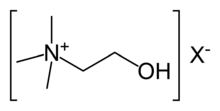
Choline

Choline /ˈkoʊliːn/ is a water-soluble vitamin-like essential nutrient. It is a constituent of lecithin, which is present in many plants and animal organs. The term cholines refers to the class of quaternary ammonium salts containing the N,N,N-trimethylethanolammonium cation (X− on the right denotes an undefined counteranion). Choline /ˈkoʊliːn/ is a water-soluble vitamin-like essential nutrient. It is a constituent of lecithin, which is present in many plants and animal organs. The term cholines refers to the class of quaternary ammonium salts containing the N,N,N-trimethylethanolammonium cation (X− on the right denotes an undefined counteranion). The cation appears in the head groups of phosphatidylcholine and sphingomyelin, two classes of phospholipid that are abundant in cell membranes. Choline is the precursor for the neurotransmitter acetylcholine, which is involved in many functions including memory and muscle control. Choline was first isolated by Adolph Strecker from pig and ox bile (Greek: χολή, chole) in 1862. When it was first chemically synthesized by Oscar Liebreich in 1865, it was known as neurine. In 1898 neurine was shown to be chemically identical to choline. In 1998, choline was classified as an essential nutrient by the U.S. Food and Nutrition Board of the Institute of Medicine. Choline and its metabolites serve three purposes: structural integrity and signaling roles for cell membranes, cholinergic neurotransmission (acetylcholine synthesis), and a source for methyl groups via its metabolite, trimethylglycine (betaine), which participates in the biosynthesis of S-adenosylmethionine (SAM). The human body can produce choline by methylation of phosphatidylethanolamine by N-methyltranferase (PEMT) to form phosphatidylcholine in the liver, or it may be consumed from the diet. The function of choline is complex, and involves interplay with folate, methionine, and vitamin B12. Methionine can be formed either from methyl groups derived from folate, or from methyl groups derived from betaine, which in turn receives its methyl groups from choline. Changes in one of these pathways are compensated for by the other. If neither pathway provides adequate methylation to produce methionine, its precursor, homocysteine, rises. Choline in food exists in either a free or esterified form (choline bound within another compound, such as phosphatidylcholine, through an ester linkage). Although all forms are most likely usable, some evidence indicates they are unequally bioavailable (able to be used by the body). Lipid-soluble forms (such as phosphatidylcholine) bypass the liver once absorbed, while water-soluble forms (such as free choline) enter the liver portal circulation and are generally absorbed by the liver. Some animals cannot produce choline and must consume it through their diet, though humans can make a small amount of choline in the liver. Diets lacking choline lead to fatty liver and muscle damage, though this effect varies amongst age groups, with men and postmenopausal women more susceptible than premenopausal women. However, choline deficiency is rare in the general population. The following are choline values for a selection of foods in quantities that people may consume in a day. Cruciferous vegetables, such as Brussels sprouts and broccoli, are good sources of choline. USDA's food composition database lists the choline content for many foods.
